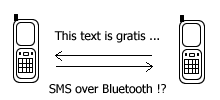A 3-in-1 (three-in-one) phone usage scenario appeared since the first version of Bluetooth specification.
Definition
It refers to a handset that can function as
1. mobile (cellular) phone when out and about within a cellular network coverage,
2. cordless phone when at home, near a fixed line (landline) telephone base station,
3. intercom (walkie-talkie) when two persons are establishing a direct speech connection in close distance.
To enable the latter two (points 2 and 3), the specification defined TCS (Telephony Control Signaling) Binary Profile which is the basis of Corldless Telephony Profile (CTP) and Intercom Profile (ICP).
Benefits
It shows a fixed-mobile convergence (though only in handset since other convergence issues relate to core network, management, numbering, billing and handover mechanism) and it allows users to bypass cellular operators when communicating within Bluetooth range. These may result in lower monthly communication bill.
If your Bluetooth mobile phone supports CTP, you don't need another cordless phone at home to receive or make a landline call.
And if in addition it also supports ICP, when - for instance - attending a class or in an exhibition zone, you want to contact another attendee you don't need to dial his/her cellphone number. Just search for his/her phone's Bluetooth device name on your screen and contact him/her via Bluetooth. Since this voice call bypasses your cellular operator, you needn't pay a penny for it.
The call is routed over Bluetooth SCO (Synchronous Connection Oriented) link, a dedicated voice link which is occupied for the duration of the call, comparable to the circuit-switched landline phone circuit.
If Bluetooth standard also formalize bluejacking by creating for instance SMS over Bluetooth profile, I think a lot of users will love Bluetooth, especially texting-intensive youngsters.
Product availability
The 3-in-1 phone concept would be very attractive to users had it been followed by the mass production of such phone which hasn't been a reality until now. Browsing the Bluetooth SIG website for products that support a 3-in-1 phone usage model ends up only to the Bluetooth specification document.
Why mobile phone vendors did not race to produce such a phone?
It seems they didn't want to upset cellular operators since in developed markets handsets are channeled through cellular operators. At the time when traditional voice operators (telcos) are facing VoIP challenge, this is a sensitive issue.
I did googling on 3-in-1 Bluetooth phone and found only one such phone, i.e. Sony Ericsson W550i even though there are several Bluetooth chip and PSTN/ISDN access point vendors who stated CTP and ICP support in their products. For example, Broadcom (who acquired Widcomm) makes Bluetooth chip and stack for embedded devices that support CTP and ICP.
If things stay the same in the near future, wouldn't the Bluetooth 3-in-1 phone usage model be buried under the shadow of the increasingly popular VoIP-capable handset? (i.e. VoWLAN or voice over Wi-Fi)
Comparing a 3-in-1 Bluetooth phone with the BT (British Telecom) Fusion's 2-in-1 Bluephone
A Bluephone works as a mobile phone when outside user's home and within BT (MVNO to Vodafone) cellular network. When user walks into his/her house, within a home Bluetooth access point coverage, if he/she is in the middle of a call, the call is switched automatically to BT Broadband landline network via the home access point. The handoff is seamless, without user intervention. This solution is applicable only to BT Broadband subscribers.
Using Bluetooth standard CTP, the switch from/to mobile and cordless is to be decided by the user if he/she is aware of the presence of cheaper landline network. This scenario can work with any mix of fixed and mobile operators.
On the walkie-talkie mode, the direct speech connection (ICP) between two persons within Bluetooth range is completely free peer-to-peer (ad hoc) link without a service provider involvement or a typical office DECT cordless base station and PBX.
Introduction to Bluetooth Profiles
Tuesday, May 09, 2006
Anyone uses a 3-in-1 phone?
A review of forgotten Bluetooth profiles
Subscribe to:
Posts (Atom)